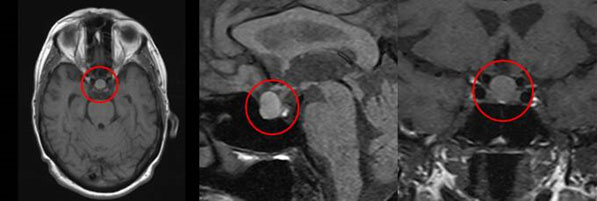Introduction
The pituitary gland (pituitary) is located in the so-called sellar region, a region of the central skull base. It produces hormones and neurotransmitters, which in turn control other glands and their processes in the body. The vast majority of tumor-like changes of the pituitary gland are benign tumors. These processes are therefore normally locally restricted and grow slowly. The pituitary adenomas are composed of two major groups: hormone-producing (mainly STH = growth hormone, Prolactin, ACTH) and not hormone-producing adenomas. In both groups, stronger growth eventually leads to rise and then compression of the optic nerve, so often blurred vision and visual field defects lead to an initial consultation with a doctor. The hormone-producing adenomas additionally make the effects of each hormone excess noticeable.

Picture: MRI-image of patient with pituitary adenoma
For the treatment, thus hormone specialists (endocrinologists) and neurosurgeons work closely together. Before deciding on the individual treatment of a patient the following examinations should be considered:
- Comprehensive evaluation of hormone situation (endocrinology)
- Magnetic resonance imaging (MRI) of the pituitary gland
- Ophthalmological examination incl. visual field.
In many cases, surgical treatment is necessary, which today can be carried out using endoscopic technology - often gently through the nose (transnasal, transsphenoidal). In other cases (e.g. prolactinomas) drug treatment may be the treatment of choice.




